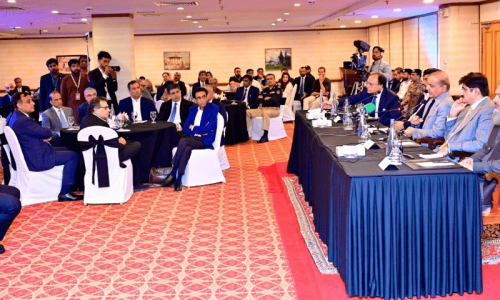WASHINGTON: The United States has reacted to Pakistan’s test-firing of its first nuclear-capable submarine cruise missile with an appeal to all nuclear weapon states to exercise restraint.
At a State Department news briefing on Monday, US government spokesman John Kirby said he had seen reports of the missile launch but, instead of focusing on Pakistan, he underlined the need for all nuclear states to avoid such tests.
“We continue to urge all states with nuclear weapons to exercise restraint regarding nuclear and missile capability testing and use, and we encourage efforts to promote confidence building and stability with respect to those capabilities,” he said.
Such references to nuclear weapon states usually imply India and Pakistan as all other states with this capability have already signed the Nuclear Non-Proliferation Treaty and abide by its guidelines.
The US media, while reporting the State Department’s reaction, noted that both India and Pakistan continue to test nuclear-capable weapons and Pakistan’s latest test “ramps up South Asia’s nuclear one-upmanship”.
CNN quoted its analysts as confirming that the Pakistani missile could carry a nuclear payload and noted that Pakistan conducted the test less than a month after India launched its Agni-V missile.
Pakistan announced on Monday that it had successfully test-fired its first submarine-launched Cruise Missile capable of carrying a nuclear warhead up to 450 kilometres. The announcement said that the new strategic weapon had given the country a “credible” second-strike capability, augmenting deterrence amid tensions with India.
The Babur-3 missile was fired from an underwater, mobile platform and an undisclosed location in the Indian Ocean and hit its target with precise accuracy, the Inter-Services Public Relations, the media wing of Pakistan Army, said in a statement.
In a separate statement, Prime Minister Nawaz Sharif said that “the successful test of Babur-3 is a manifestation of Pakistan’s technological progress and self-reliance.”
A retired Pakistani army officer, Lt Gen Talat Masood, told CNN that this attempt by Pakistan to develop a genuine second-strike capability was “only the beginning”.
But maintaining second-strike capability — the ability to hit an adversary back after already being attacked — with a submarine fleet was costly, both financially and diplomatically, he said.
CNN also referred to a Jane’s Defence Weekly report, saying that Pakistan currently had eight submarines in its fleet and Mr Masood told the US media outlet that to “realistically deter an enemy, three of them would have to be equipped with working nuclear-capable missiles”.
Several US media outlets included assessments by their own analysts who said that Pakistan had been working on its second- strike capability for some time, “so the timing may not have been affected by India’s launch”.
Bharat Karnad, a research professor at India’s Centre for Policy Research, however, told CNN that the Pakistani test was not a major threat to India. “It is a threat, but something the Indian navy is confident it can deal with.”
Mr Karnad said that it made sense for Pakistan to “publicly trumpet its missile launch to dissuade adversaries from moving against Islamabad”.
The Indian expert also mentioned a nuclear chain, starting from Pakistan and ending at the United States. While Pakistan focused on India, the Indians “have got their eye on China, and China in turn is focused on the United States. It’s a nuclear daisy chain to which there is really no solution,” Mr Karnad said. “It is the largest strategic problem for the region.”
CNN claimed that Islamabad developed the Babur-3 after reverse-engineering US missiles discovered nearly intact in Pakistan in the 1990s.
It also referred to the ISPR statement that the missile had “state-of-the-art technologies, including underwater controlled propulsion and advanced guidance and navigation features”.
The missile also had terrain hugging and sea skimming flight capabilities to evade hostile radars and air defences, in addition to certain stealth technologies, the report added.
While Mr Karnad predicted a muted response from India, Jane’s Defence Weekly warned that the launch was likely to increase tensions between Pakistan and India due to recent instability in Kashmir.
Jane’s noted that the missile, also known as Hatf 7, was believed to have a maximum range of 700km.
Published in Dawn January 11th, 2017














































